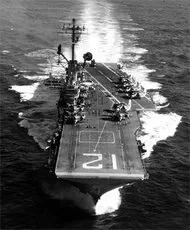by T. Duplain
 The USS Hornet CV-12 was the eighth United States ship to use the hornet name. The first Hornet was a ten-gun sloop commissioned in 1775, and served in the American Revolutionary War against Great Britain; it was one of the first two ships in the new Continental Navy.
The USS Hornet CV-12 was the eighth United States ship to use the hornet name. The first Hornet was a ten-gun sloop commissioned in 1775, and served in the American Revolutionary War against Great Britain; it was one of the first two ships in the new Continental Navy.
The second Hornet was also a ten-gun sloop and took part in the First Barbary War. In company with two other American ships, she attacked the port of Derna and silenced its guns in a battle lasting less than an hour. This allowed a combined force of about 400 United States Marines and Arab, Greek, and Berber mercenaries who had made a gruelling 400 mile overland march to capture the city - an event immortalized in the Marine Hymn "To the shores of Tripoli."
The third Hornet was a brig-rigged sloop of war and was launched on July 28, 1805 in Baltimore. It was later commissioned on October 18, 1805. The Hornet sank in a storm off Tampico, Mexico on September 29, 1829 with the loss of all on board.
The fourth Hornet was a five gun schooner used as a dispatch vessel between 1813 and 1820.
The fifth Hornet, the first to be steam propelled, was an iron, side-wheeled steamer.
The sixth Hornet, a converted yacht, was a dispatch vessel in the Spanish-American War.
The seventh Hornet, CV-8, launched the Doolittle Raid in 1942 along with Enterprise, fought at the Battle of Midway, and was sunk at the Battle of the Santa Cruz Islands on October 26, 1942.
The eighth Hornet (CV/CVA/CVS-12) was originally named Kearsarge, but renamed in honor of CV-8 and active through the rest of World War II. It was commissioned in 1943, during World War II. In the Pacific side of the war, the USS Hornet CV-12 destroyed 1,410 Japanese aircrafts and damaged 1,269,710 tons of enemy shipping. Ten USS Hornet CV-12 pilots achieved "Ace in a Day" positions. The USS Hornet CV-12 pilots are also given credit for the first strikes against Tokyo since the 1942 Doolittle Raid. The ship supported almost every Pacific amphibious landing after March 1944 and struck the decisive first hits in sinking the super battleship, Yamato. During the Cold War, the USS Hornet CV-12 had the honor of recovering astronauts from the Apollo 11 and Apollo 12 missions. She is preserved as a museum ship in Alameda, California.
The USS Hornet CV-12 experienced over 300 casualties in 27 years of servitude to the United States Navy. These numerous fatalities are mainly due to war, but many deaths were results of accidents or suicides. In fact, the USS Hornet CV-12 has the highest suicide rate in the Navy. Sailors have walked into aircraft's rotating props. They’ve been sucked into their air intakes and then are driven off deck by their exhaust.
Crew and visitors have reported a large number of strange occurrences, sightings, and noises on the now, infamous ghost ship. Entrance openings and closings by themselves, belongings that disappear, only to resurface after a long hunt, things that shift across the ground or drop off shelves without explanation, phantom sailors that progress through the vessel as if doing orders from another time, toilets that flush themselves, uncanny presences felt, and sensations of being taken hold of or pushed when no one is near.

